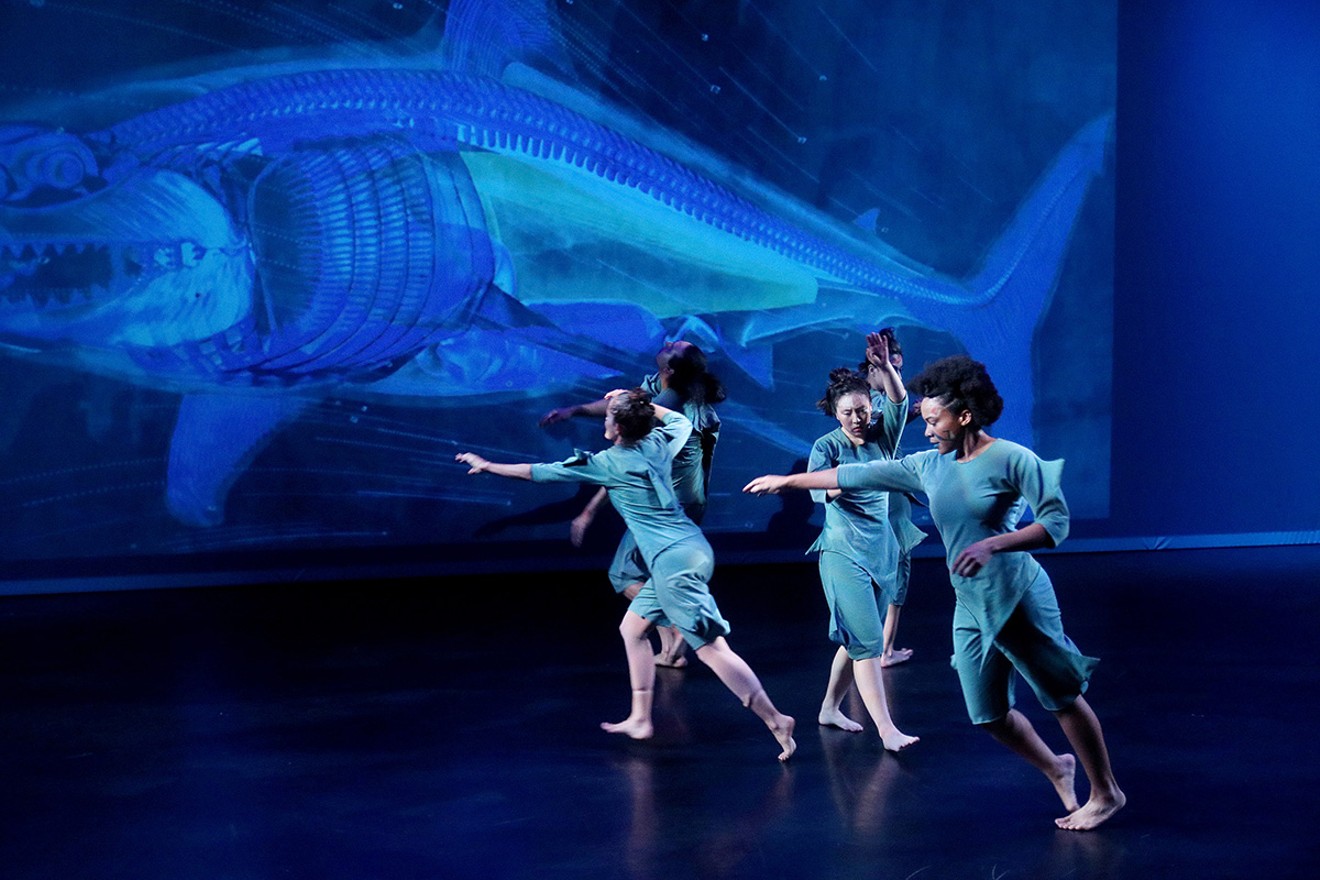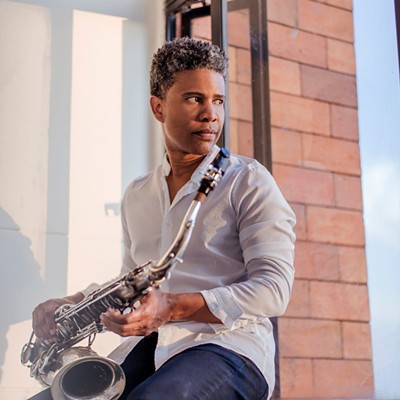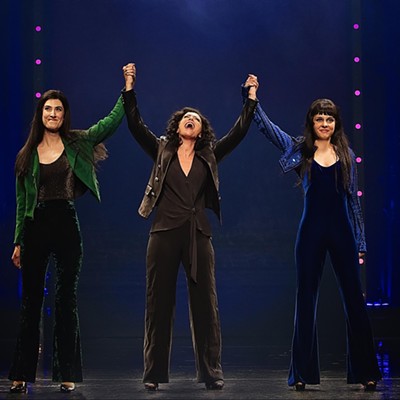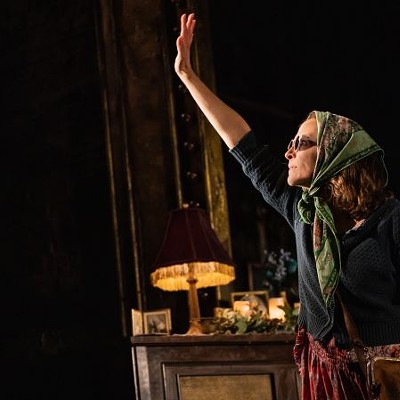As the artistic director of one of Houston’s longest-running dance companies, she not only is the choreographer, but creates her own costumes and builds her own music. And she’s also worried about ticket sales. Getting people to come to modern dance isn’t an easy thing these days, but there’s also the inconvenient truth that September 21 is less than five weeks removed from the devastation of Hurricane Harvey. Are people ready to pay $25 to see a rainbow-colored fantasia about the depths of the sea?
Wood has been producing work since the early 1990s. Her Suchu Dance was incorporated as a nonprofit in 1998, she has founded three art spaces (including Barnevelder Movement Arts Complex) and she’s one of only three Houston dance entities to have been invited to present work at the esteemed Jacob’s Pillow Inside/Out program. But the struggle for audience numbers is still very real.
“I try and divorce myself from worry about what’s appealing to people, but I’m always thinking about it,” she says. “When I’m in the process of creating things and putting on a show, I think about it less, but there’s definitely a tug-of-war between wanting to do something interesting and doing something that people want to see. I have to think about ticket sales, unfortunately.”
Dance, as Wood and many others in Houston’s arts community know, doesn’t come cheap.
————
While Wood contemplates the challenges of building a new audience for the rest of her season, two former Suchu Dance company members are busy rising to the occasion, albeit in quite different ways. Ashley Horn, an independent choreographer and costume designer, has been making work for ten years, and has been creating evening-length enchantments of dance wonder and whimsy since 2013. Stepping into a Horn universe is like wandering through a fairy tale; in Wishing Well, she took her audience on a frolic through Smither Park and the Orange Show that evoked the folk-arts movement that spawned Jeff McKissack’s iconic monument.
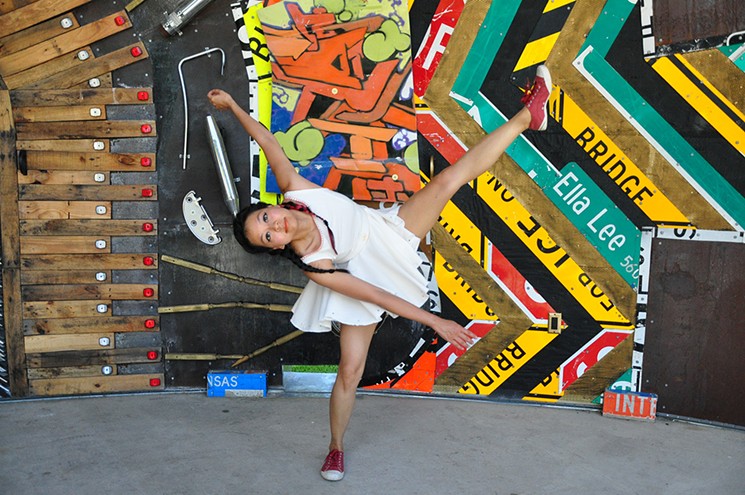
In addition to the hour of rehearsed choreography, she created an onstage maze using black fabric hanging from the rafters for a 15-minute interactive prelude. The audience entered the stage-area maze, and could wander the rooms and observe dancers performing improvised rituals based on the relics in each space. Then the fabric lifted and the more traditional part of the show began. Not the typical start to a dance concert, and one that proved to be a smart choice for an audience looking for a breath of fresh air.
For Horn, the maze was an extension of the show’s thematic content. “I have a long, winding history with religion,” she says. “I grew up in a certain religion, and I went to a strict Christian college, so [the maze] had a religious aspect for me.” As with most Protestant-based faiths, Horn’s religious upbringing included a strong aversion to idols and pageantry, but a brief acquaintance with the Greek Orthodox Church opened her eyes to the beauty of rituals. “As soon as you walk into the church, the worship begins. Vesper was a religious service. The maze was that beginning worship. You see the icons, you kiss them, you see the holy water and you prepare yourself.”“People are inundated with stimulus now. To get people to go to the theater and watch dance is challenging." — Houston-based independent choreographer Ashley Horn
tweet this
But there is also an element of finding new dance audiences and expanding on the following that she already has, which is no small endeavor. “People are inundated with stimulus now,” says Horn. “To get people to go to the theater and watch dance is challenging. There are so many options for entertainment, so it’s easy to stay home because it’s just convenient.” So does this mean creating work that can rival the endless possibilities of Netflix? Not quite. “I don’t want to feed into the over-stimulus frenzy, but at the same time I want to make work that’s appealing to the audience while also staying true to myself as a choreographer.”
Horn is preparing to explore the interactive element of Vesper in a much bigger way. She’s in the pre-production stages of an immersive evening-length work set to premiere in late February 2018 at a new arts space in town. She’s teaming up with music artist Slow Meadow and photographer Pin Lim to give Houston its own answer to New York City’s Sleep No More, the famous theatrical production by British troupe Punchdrunk that offers its audience an individualized experience that travels through five stories and three hours of Macbeth-style psychological drama.
Horn’s work will include a large-scale set built out of books and book pages and basic animation toys. She’s also planning on using Pin Lim’s photography to create interactive elements that include mystery-solving and narrative-building. The piece is inspired by the neuroscience of memories, and is in many ways, the culmination of all of her previous work. “I’ve been doing all of my research, and I feel like everything I’ve been doing the last few years has been preparation for this,” she says.
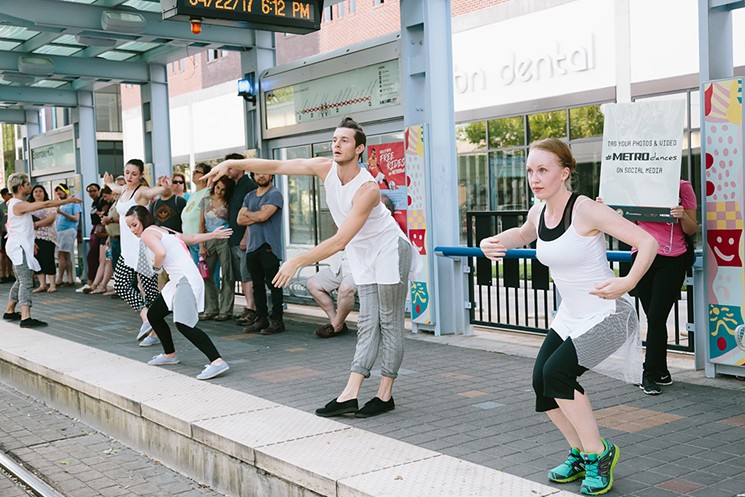
“I think attending arts performances and understanding how art can impact us is not often instilled or taught at a young age,” says Hance. “A lot of people don’t know that they’re missing it, and so it’s not a priority for them. That’s why I want to put dance in front of them.” She’s done so in the most intriguing of ways. Just take her Tunnel Visions, a series of performances in the fall of 2015 that took her dancers into the downtown tunnel system to be witnessed by hundreds of pedestrians during lunch hour.
The idea for METROdances came about during a time when she was thinking about how dance could travel, not in the sense of moving through space but how dance could possibly move a stage. Hance, a native of San Francisco, recalls that city’s annual Trolley Dances, which sees the public transported from performance area to performance area via the iconic trolley cars. Hance’s project is a different concept, and sees the performers traveling the route along with the audience and actually performing on the vehicles. The first METROdances was a relatively small affair that included three dancers, four percussionists, and one audience group. The latest installation was exponentially larger, with ten professional dancers, a percussion quartet, a brass quintet, a brass trio, two of Hance’s student/community ensembles, and a longer route.
As might be expected, sometimes unwitting audience members are caught off guard. Just imagine you’re on the rail to make a downtown appointment or get back into your office before your break ends, and then a dancer you thought was a fellow commuter in stylized dress begins to move in front of you up close and personal. “I always say that what I do is more of a social experiment rather than a performance,” says Hance. “I had a couple of guys with instruments actually start playing and jamming during a rehearsal. Rehearsing invited that type of engagement a bit more because it didn’t look like a performance.” She also cites instances of people purposefully missing their stops to continue watching, and one man skipping his lunch break to see the full performance. For Hance, it’s all about making dance a priority for Houstonians.
“We go to those things that are going to be fun or fulfilling,” she says. “We all have very limited time. Dance has to be one of those things that we seek.” Hance is making METROdances a part of her company’s regular programming so that she can explore different parts of the rail every couple of years and introduce even more Houstonians to her work."What I do is more of a social experiment rather than a performance." — Lydia Hance of Frame Dance Productions
tweet this
Like Horn, Hance is in the early stages of an evening-length, immersive work to premiere in May 2018. Blueshift will take place in a high-school gymnasium and will use the text from love letters gathered from the Houston community.
To be clear, reaching the masses is not about making modern dance a commercial venture. It’s about accessibility and putting it into the audience’s path. Also like Horn, Hance wants to increase the visibility of the form, but not at the expense of the artistry. “I’m working to give Houston dance in my authentic voice,” she explains. “I’m not making dance more exciting, but giving it to people in smaller doses or areas where they already go. That’s how I’m trying to counteract the challenge of audience-building — they have the option to stay for a whole hour or just walk away.”
————
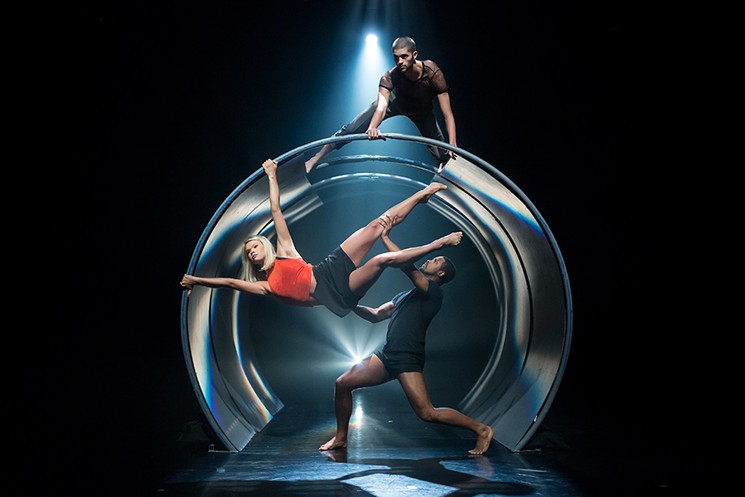
The Nobles’ Zilkha Hall engagements are large-scale productions with equally large themes. The show titles say it all: Storm Front, Supernova and, most recently, Catapult. At the time of this writing, the Nobles were hard at work rehearsing for the latter, which was rescheduled from August 25 and 26 to September 29 and 30 because of the fury of Hurricane Harvey.
Catapult promises to offer some high-flying, daredevil dancing courtesy of nifty industrial design by company member Jared Doster. The initial idea for this particular dance has been sitting with Andy since 2008, when he was thinking about portraying two sides of a single society using a simple, everyday mechanical device: a door. “One side would show the working class, and the other side would show the aristocracy,” says Andy. “The working class would manipulate the doors so that the elites could move across them and do different things.”
When he approached Doster, who holds a degree in industrial design, about his idea, the longtime company member said he could build it. “From there, I thought it would be an interesting idea to build an evening around,” says Andy. “To have a common object like a door, and to change the expectations of what is there, to use it to alter physics and the dancers’ interaction with gravity.” Catapult turned out not to have the social commentary of the original idea, but it still sees dancers hurtling through space.
Bigger is better is the key ingredient in the NobleMotion formula. Before coming to Houston, the Nobles had a small pickup company in Florida. Artistically the work was fulfilling, and it was primarily solos, duets and intimate pieces. Though they had a small following, the creative output didn’t allow for them to build a large audience.
When they relocated to the Houston area and began teaching at Sam Houston State University, they asked themselves how it might be possible to make a splash in an already thriving dance community.
“The answers we’ve been playing with include collaboration with other art forms, which has been a big part of it, and creating an element of spectacle,” says Andy. “Our physicality is big, and we use dancers who are fearless and will take risks. We also make large works with larger casts.” Both of his parents are playwrights, so he makes use of his strong theater background to capture the attention of his audiences. Movement alone is a hard sell.
His wife, Dionne Sparkman Noble, feels that concert dance often lacks context, which is necessary for broad appeal. “It’s really hard to take a stark, rectangular proscenium stage and give it context,” she says. Whereas her husband often employs state-of-the-art lighting for his pieces, Dionne takes a more understated approach. “I used to want to be a visual artist. I think I paint onstage a little bit. I usually have some type of visual element, something onstage that the dancers can push up against. This gives context to the audience.”“We grab people by the hand and bring them to our shows." — Andy Noble of NobleMotion Dance
tweet this
The Nobles also spend a lot of time reaching out to people and getting them invested in their dancers and their work. “We grab people by the hand and bring them to our shows,” says Andy. “We work really hard at it.” In addition to putting up Catapult, which was funded in part by a grant from the Mid-America Arts Alliance, the company implemented an aggressive outreach program, which saw dancers and engineers go to student dance populations and conduct workshops that allowed participants to create work with an interactive set piece. In effect, the kids were able to simulate the experience of Catapult, but in a much safer environment.
Next year NobleMotion Dance goes into its tenth season, and there’s no loss of momentum as it finishes its first decade. “I’m really proud of us for sticking it out this long,” says Andy. And with an assortment of ideas to play with and a proven formula for success, longevity doesn’t seem to be a problem.

